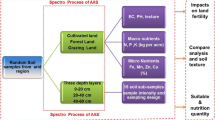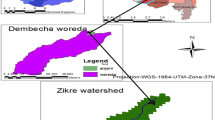Abstract
Soil is the primary foundation of the agroeco-system. Kee** in view such scenario, the soil potential physio-chemical properties and their impacts on sustainable land use planning over the Neelam river basin, AJK, Pakistan has been investigated. Soil potential and their physicochemical properties using the survey method at various classes of land use in the AJK regions were measured. The results of the study revealed that soil fertility was categorized into very low, low, medium, high, and very high fertility classes. The outcome of the survey showed that 66.95% sand and 23.91% soil elements were measured in the forest layer, and 37% clay elements in the subsurface layer of cultivated land. The high (58.09%) and low (49.34%) mean TP values were observed in cultivated and forest land areas, respectively. About 52.61% of Neelam valley was detected below low organic matter (OM) classification. Comparatively, a high total nitrogen nutrient (0.121%) was found high in the cultivated land. K nutrient particles 93.15 mg kg−1 and 23.47 mg kg−1 were recorded for cultivated and forest layers, respectively. The higher (61.54%) and lower (25.14%) values of PBS were observed for cultivated and forest land. Furthermore, Mn > Fe > Cu > Zn order of the micronutrient quantity has been recorded for all land types over the Neelam valley, Pakistan. The results of the study predicted that the potential of soil nutrients is essential for green innovation and green economic growth, which positively contributes to sustainable land use planning.







Similar content being viewed by others
References
Abayneh E, Gebeyhu B, Kebede A (2001) Soils of Areka; Agricultural Research Center. EARO, Addis Ababa, Ethiopia.
Abbas S, Shirazi SA, Qureshi S (2018) SWOT analysis for socio-ecological landscape variation as a precursor to the management of the mountainous Kanshi watershed, Salt Range of Pakistan. Int J Sust Dev World 25(4):351–361
Abbasi MK, Rasool G (2005) Effects of different land-use types on soil quality in the hilly area of Rawalakot Azad Jammu and Kashmir. Soil Plant Sci 55(3):221–228
Abbasi MK, Zafar M, Khan SR (2007) Influence of different land-cover types on the changes of selected soil properties in the mountain region of Rawalakot Azad Jammu and Kashmir. Nutr Cycl Agroecosyst 78:97–110
Abera D, Agere Lupi GA, Hundesa M, Bekele I, Aboye K, Mohammed J, Ademe F (2019) Soil fertility management research: major achievements, challenges, and prospects. MERCI project TERRA project.
Abreha K, Heluf G, Tekalign M, Kibebew K (2012) Impact of elevation and land use type on some physical and chemical properties of acidic soils in Tsegede highlands, Northern Ethiopia. Open J Soil Sci 2:223–233
Agriculture Department. (2016). Muzaffarabad AJ&K.
Ahmad KS, Kiyani WK, Hameed M, Ahmad F, Nawaz T (2012) Floristic diversity and ethnobotany of Senhsa, District Kotli, Azad Jammu & Kashmir (Pakistan). Pak J Bot 44:195–201
Ahmed H (2002) Assessment of spatial variability of some physico-chemical properties of soils under different elevations and land use systems in the western slopes of Mount Chilalo, Arsi. M.Sc. Thesis Submitted to the School of Graduate Studies, Alemaya University, Ethiopia. p 111
Alemayehu T (1990) Soil and irrigation management in the state farms. In: Proceedings of the First Natural Resources Conservation Conference. Natural Resource Degradation: A Challenge to Ethiopia. Institute of Agricultural Research (IAR), Addis Ababa, Ethiopia: pp 47–52.
Bewket W, Stroosnijder L (2003) Effects of agro ecological land use succession on soil properties in Chemoga watershed. Blue Nile basin, Ethiopia. Geoderma 111:85–98
Bhowmik A, Kukal SS, Saha D, Sharma H, Kalia A, Sharma S (2019) Potential indicators of soil health degradation in different land use-based ecosystems in the Shiwaliks of Northwestern India. Sustainability 11(14):3908
Bohn HL, McNeal BL, O’Connor GA (2001) Soil chemistry. 3rd edn. John Wiley and Sons, Inc., USA. vol 111, p 85–98
Doretto A, Piano E, Larson CE (2020) The River Continuum Concept: lessons from the past and perspectives for the future. Can J Fish Aquat Sci 77(11):1853–1864
FAO, (Food and Agricultural Organization). (2006a). Plant nutrition for food security: A guide for integrated nutrient management. FAO, Fertilizer and Plant Nutrition Bulletin 16. FAO, Rome.
FAO, (Food and Agricultural Organization). (2012). Harmonized world soil database (Version 1.2). FAO, Rome, Italy.
FAO, (Food and Agriculture Organization) (2006b) Guidelines for soil description, 4th edn. FAO of the United Nations, Rome
Fasina A (2004) Influence of land utilization types on topsoil properties of a ultisol in Southwestern Nigeria. J Sustain Agric Environ 6:171–178
Fassil K, Yamoah C (2009) Soil Fertility Status and Numass Fertilizer Recommendation of Typic Hapluusterts in the Northern Highlands of Ethiopia. World Appl Sci J 6:1473–1480
Gazey C, Davies S (2009) Soil acidity: A guide for WA farmers and consultants. Department of Agriculture and Food, Western Australia, Perth.
Gebeyaw, T. (2007). Soil fertility status as influenced by different land Uses in Maybar areas of South Wello Zone, North Ethiopia. MSc Thesis, Haramaya University, Haramaya, Ethiopia.
Girma A, Endalkachew WM, Bakken LR (2012) Carbon and nitrogen mineralization dynamics in different soils of the tropics amended with legume residues and contrasting soil moisture contents. Biol Fertil Soils 48:51–66
Houghton RA, Hacker JL, Lawrence KT (1999) The U.S. carbon budget: contribution from land use changes. Science 285:574–578
Ibrahim AK, Abubakar B (2013) Extractable micronutrients status with other soil properties in Jangargari, Yamaltu-Deba Local Government Area, Gombe State. Asian J Agric Food Sci 1(5):217–221
Indian Society of Soil Science. (2002). Fundamentals of soil science. Division of soil science and agricultural chemistry, Indian Agricultural Institute, New Delhi.
Islam KR, Weil RR (2000) Land use effects on soil quality in a tropical forest ecosystem of Bangladesh. Agric Ecosyst Environ 79:9–16
Jackson R, Thompson J, Kolka R (2014) Wetland soils, hydrology, and geomorphology. University of California Press
Jaiyeoba IA (2003) Changes in soil properties due to continuous cultivation in Nigerian semiarid Savannah. Soil Tillage Res 70:91–98
Jourgholami M, Ghassemi T, Labelle ER (2019) Soil physio-chemical and biological indicators to evaluate the restoration of compacted soil following reforestation. Ecol Ind 101:102–110
Kang B, Juo A (1986) Effect of forest clearing on soil chemical properties and crop performance. In: Lal, R, Sanchez PA, Cummings Jr., RW (eds.).
KIC, (Kollomorgen Instruments Corporation). (1994). Munsell soil color charts. Revised edition. Macbeth Division of KIC. 405 Little Britain Road, USA.
Mesfin A (1998) Nature and management of Ethiopian soils. Haramaya University of Agriculture/ILRI, Addis Ababa, Ethiopia
Mesfin A (1996) The challenges and future prospects of soil chemistry in Ethiopia. pp 78–96. In: T Yizengaw, E Mekonnen and M Behailu (eds) Proceedings of the 3rd Conference of the Ethiopian Society of Soil Science (ESSS). Addis Ababa, Ethiopia, pp 28–29
Mohammed A, Leroux PAL, Barker CH, Heluf G (2005) Soils of Jelo micro-catchment in the Chercher Highlands of Eastern Ethiopia: I. Morphological and physio-chemical properties. Ethiop J Nat Res 7(1):55–81
Namu H, Hundema T (2019) Soil Fertility Assessment and Map** at Dama District, Guji Zone, Oromia Ethiopia. pp 36–46
Nega E, Heluf G (2013) Effect of land use changes and soil depth on soil organic matter, total nitrogen and available phosphorus contents of soils in Senbat Watershed, Western Ethiopia. ARPN J Agric Biol Sci 8(3):206–2012
Olowolafe EA (2004) An evaluation of soil fertility indicators using soil survey data on the Jos Plateau, Nigeria. J Environ Sci 8(2):54–61
Prasad R, Power JF (1997) Soil Fertility Management for Sustainable Agriculture. Lewis Publishers is an imprint of CRC Press, New York
Rabot E, Wiesmeier M, Schlüter S, Vogel HJ (2018) Soil structure as an indicator of soil functions: a review. Geoderma 314:122–137
Rao KS, Pant R (2001) Land use dynamics and landscape change pattern in a typical micro watershed in the mid elevation zone of central Himalaya, India. Agr Ecosyst Environ 86:113–123
Rasool R, Kukal SS, Hira GS (2007) Soil physical fertility and crop performance as affected by long term application of FYM and inorganic fertilizers in rice–wheat system. Soil Tillage Res 96:64–72
Sharma VK, Anil KH (2003) Characterization and classification of the soil of upper Maul Khad catchment in wet temperate zone of Himachal Pradesh. Agropedology 13:39–49
Singh M, Sinha R (2020) Distribution, diversity, and geomorphic evolution of floodplain wetlands and wetland complexes in the Ganga plains of north Bihar India. Geomorphology 351:106960
Sitanggang M, Rao YS, Nayan A, Mahapatra SK (2006) Characterization and classification of soils in watershed area of Shikohpur, Gurgaon district, Haryana. J Indian Soc Soil Sci 54:106–110
Swarnam T, Velmurugan A, Rao Y (2004) Characterization and classification of some soils from Shahibi basin in parts of Haryana and Delhi. Agropedology 14:114–122
Taye B, Yifru A (2010) Assessment of soil fertility status with depth in wheat growing Highlands of Southeast Ethiopia. World J Agric Sci 6:525–531
Thangasamy A, Naidu MVS, Ramavatharam N, Raghava RC (2005) Characterization, classification and evaluation of soil resources in Sivagiri micro watershed of Chittoor district in Andhra Pradesh for sustainable land use planning. J Indian Soc Soil Sci 53:11–21
Tuma A, Tesema T, Mekonen A (2013) Rating and correlating physico-chemical properties of Eutric Vertisols in Abaya Chamo Lake basin, South-west Ethiopia. Int J Agron Plant Prod 4(5):3559–3568
Tuma A, Mekonen A, Tesema T, Degife A (2014) Evaluating the Status of micronutrients under irrigated and rainfed agricultural soils in Abaya Chamo Lake Basin, South-west Ethiopia. J Sci Res Rev 3(1):018–027
Vakanjac BB, Jelić IV, Rikalović MG, Ristić-Vakanjac VR, Nikezić DP, Naunović ZZ, Dimović SD (2019) Investigation of accessory elements of representative petrologic radioactivity carriers at Stara Planina, Serbia. Nuclear Technol Radiat Protect 34(4):384–391
Wakene N, Heluf G (2003) Forms of phosphorus and status of available nutrients under different land use systems of Alfisols in Bako area, Ethiopia. Ethiopian J Nat Resour 5(1):17–37
Wang C, Zheng MM, Chen J, Shen RF (2021) Land-use change has a greater effect on soil diazotrophic community structure than the plant rhizosphere in acidic ferralsols in southern China. Plant and Soil 462:1–14
Woldeamlak B, Stroosnijder L (2003) Effects of agro-ecological land use succession on soil properties in the Chemoga watershed, Blue Nile basin, Ethiopia. Geoderma 111:85–98
Wondimagegne C, Abere M (2012) Selected physical and chemical characteristics of soils of the middle awash irrigated Farmlands, Ethiopia. Ethiopia J Agric Sci 22:127–142
Yeshanew A, Welfgang Z, Guggenbeyer G, Tekalign M (2004) Soil aggregation and total and particulate organic matter as affected by conversion of native forests to 26 years continuous cultivation in Ethiopia. Soil Tillage Res 94(1):101-108
Yu F, Lin J, **e D, Yao Y, Wang X, Huang Y, Li Y (2020) Soil properties and heavy metal concentrations affect the composition and diversity of the diazotrophs communities associated with different land use types in a mining area. Appl Soil Ecol 155:103669
Acknowledgements
This research work declares the equal efforts of S. Abbas, M. Jamil and Farzana Ahmad. The authors gratefully acknowledge the data provided by WAPDA (Water and Power Development Authority) and Soil Survey of Pakistan.
Author information
Authors and Affiliations
Corresponding authors
Additional information
Editorial responsibility: Samareh Mirkia.
Rights and permissions
About this article
Cite this article
Abbas, S., Mazhar, N., Jabeen, S. et al. Soil potential in physicochemical properties and its impacts on sustainable land planning, Neelam River Basin, AJK, Pakistan. Int. J. Environ. Sci. Technol. 19, 9329–9344 (2022). https://doi.org/10.1007/s13762-021-03800-6
Received:
Revised:
Accepted:
Published:
Issue Date:
DOI: https://doi.org/10.1007/s13762-021-03800-6




